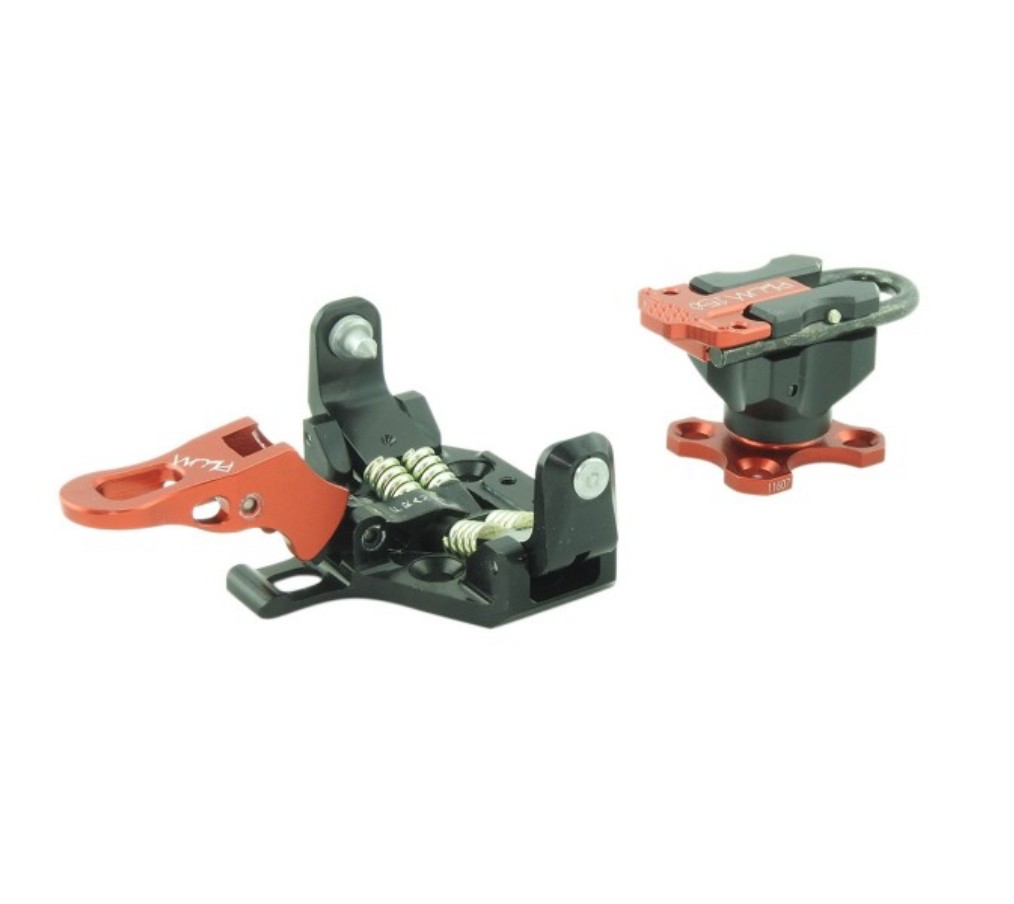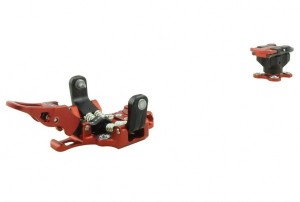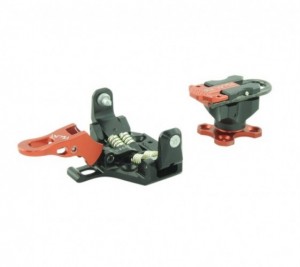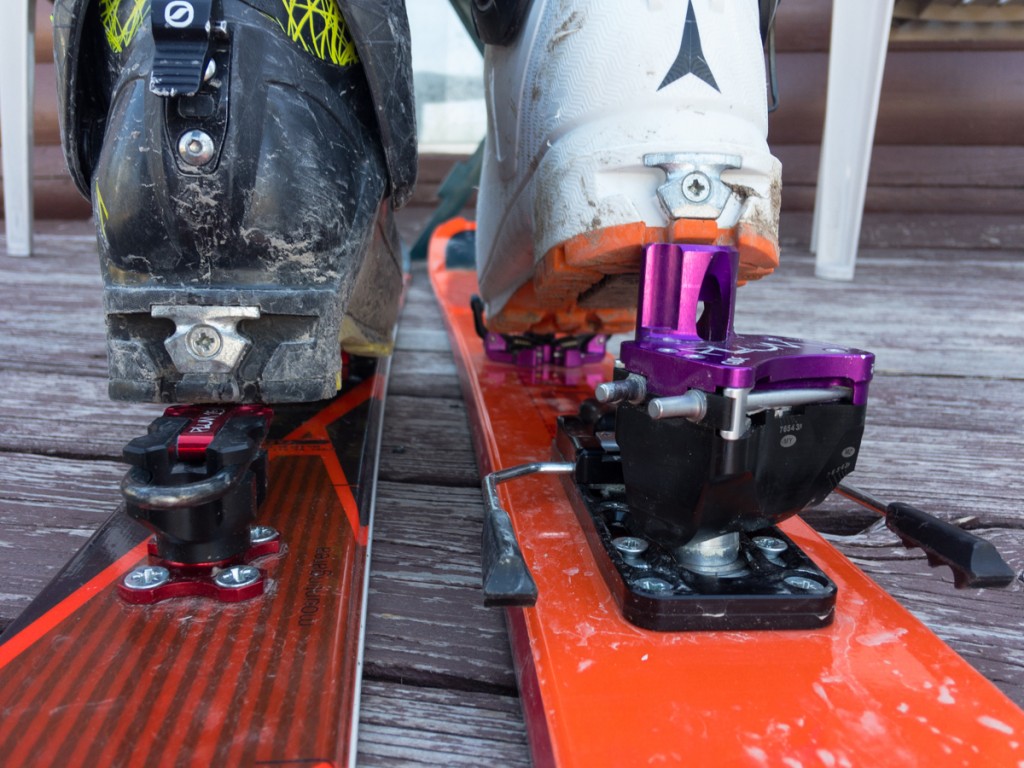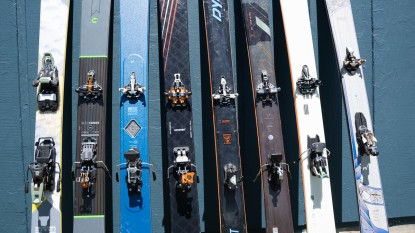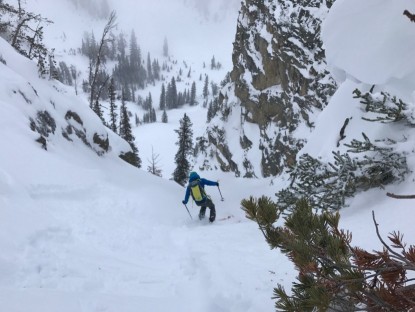Plum released some updates for this binding. It's now called the R150; details to follow.
September 2019Plum Race 150 Review
Our Verdict
Our Analysis and Test Results
New R150 vs. Race 150
Since we last tested the Race 150 binding, Plum revised it, renaming it as the R150. The R150 binding has an updated design on the toe lock, meant to improve the step-in of the binding. There is an included crampon slot (it was previously optional), and the pins are now higher, allowing for a flatter position when skiing. Compare the new R150 in the first photo to the Race 150 we tested, second photo.
Hands-On Review of the Race 150
A “skimo” race style binding that is, ostensibly, manufactured with more durability. The all-metal construction tempts one into using it for “day to day” backcountry skiing. We can endorse this sort of use, with caveats. Read on for more.
This is a specialized piece of equipment. As such, when compared to more versatile, all around equipment, its overall score inherently suffers. However, for the right user and usage patterns, this binding could be just right.
Touring Performance
Paradoxically, the ultralight construction of the Race 150 actually somewhat compromises touring performance. Of course, one could consider weight as an attribute of touring performance. However, we choose to separate that out into its own scoring metric. When we do that, we look here at only the mechanical touring performance. We consider range of motion, how the weight is distributed, and the ergonomic features like heel lifters. The Race 150 has excellent range of motion, with none of the binding weight lifting in touring mode. What it lacks is a choice of heel lift. You can tour in exactly two slightly different positions. There is not a “stiletto” heel lift mode. For beginning backcountry skiers, this gap will be sorely noticed. On the flip side, the usage patterns of the world's best ski mountaineers shows that moderate heel lift is all that is needed. Everything that has been skied has been skied on race-style ski gear. The best in the world are doing so on race-style bindings.
You choose these bindings for simplicity and light weight. You compromise “performance” across the board. That your touring comfort and ergonomics will suffer with more touring oriented gear like this is a bit hard to swallow, but it is nonetheless a truth. The more “all around” bindings will tour better. The extensive touring features of the G3 Ion LT and the Editors Choice Atomic Backland Tour are more suited to beginner skinners than the stripped down Tech Race. Even the beefy Top Pick Fritschi Tecton has more heel elevation options than the Race 150.
Downhill Performance
Just like with touring performance, and even more so, you do not choose this binding for downhill performance. First, and most importantly, release tension is fixed and directions of release are limited. No third party certifying body has inspected and approved of the release function of the Race 150. If you desire lower release values, you will be locked into the Plum harder than you want. If you desire higher release values, you risk coming out unexpectedly or you must choose (against manufacturers and OGL recommendations) to lock the toes of the bindings and being essentially bolted to your skis.
In terms of downhill performance, we also consider stack height and binding delta. Stack height is the distance of your boot sole from the ski top sheet and binding delta is the difference in height between toe and heel. We carefully measured these things and found the Race 150 to have very low values of both. Both are debatable as to their impact on performance. Most agree that, with backcountry skis, boots, and usage patterns, stack height doesn't matter too much and that binding delta has a sweet spot that is considerably more than what the Race provides. The most potential dramatic issue with stack height comes when the user has wide boots, narrow skis, and steep, firm terrain. In these specific conditions, lower stack height makes it more likely that you will “boot out”, or bump your boot into the snow surface, dislodging edge grip. Binding delta (heel higher than toe) helps some skiers adjust their stance in otherwise soft and upright lightweight touring boots. Fact is, our test team made up mainly of skiers with good, adaptable technique could hardly notice the differences in stack height and binding delta. Nonetheless, some will really notice this and need to consider it in their binding choices.
The Race Tech 150 has, objectively, poor downhill ski performance. However, we'd argue that something like 90% of a binding's downhill job is to simply hold your heel and toe in place while you wiggle your butt. The Race does this just fine. For emergencies and for really serious skiing we further distinguish bindings by examining that remaining 10%. In some ways, we ("we" being the entire ski equipment community) exaggerate the importance and impact of things like release value, binding geometry, and elasticity. When we examine carefully and academically, it is clear that something like the Top Pick Fritschi Tecton has much better downhill performance than the Race. However, when you look at the gnarliest of backcountry skiing, you see a remarkable amount of this race style equipment. In application, the Plum bindings do all that most need them to do and do it well. Everything that can be skied has been done on race bindings. The Top Pick Helio 180 has slightly better downhill performance for one simple reason. At time of purchase you can select one of three different release values for the Helio. There is only one option with the Plum.
Ease of Use
Simplicity makes for easy use. Step in, lock the toes, skin away. Switching to ski mode requires a manual (like, with your actual “manus” -Latin for hand) reach and flip. Hip-mobility-challenged skiers will be a little bummed out by this; some bindings you can flip to ski mode with a pole. Switching to uphill mode from ski mode requires exiting the binding and stepping back in. This is typical of most tech style ski bindings.
We had one fairly serious usability issue with the Race 150. One tester, on one long tour had the toe piece lock onto his boot. No amount of field wrestling could get it off. It wasn't until we returned all the way home, slept a night, and got the whole boot/ski/binding combination onto a workbench with a vice that we could disassemble the binding enough to get the boot out. This is not an operation that would have been real feasible in the field. We have read online rumors of this problem and rumors of a parts change that serves as a solution. With great difficulty, we secured a replacement part, but it is still not clear that the part we have is better or if it is vulnerable to the same problem. Customer service with Plum was difficult, to put it mildly.
These bindings are basically exactly what the fastest backcountry skiers in the world use to win races. In those races, the keys are giant legs, voluminous lungs, and lightning-fast transitions. Well practiced, the Race 150 enables the fastest possible transitions.
Few bindings are as simple as the Race 150. The Best Buy Dynafit Speed Turn comes close. Interestingly, the Editors Choice Atomic Backland Tour provides nearly full functionality with only a little bit of extra complication. The G3 Ion LT is super simple to get in and out of, and the heel lifters work better than most.
Other bindings smooth transitions with features and mechanics. The brakes of the Editors Choice Atomic Backland Tour deploy and stow with a hinged plate. The heel piece of the Plum Guide turns to move between ski, tour, and heel elevated modes. The Tech Race 150 speeds transitions by eliminating features. No leashes, no brakes, no heel elevation options. Just toe pieces that lock or don't, and a heel piece that locks with prongs and remains unlocked with a flap that covers said prongs. Simplicity. Ease of use of the Top Pick Black Diamond Helio is right on par with the Plum, minus the Plum's toe piece stuck issue.
Weight
Weight is king, for human-powered endeavors. For backcountry skiing, the main reason you would choose the Race 150 is weight. It is for weight savings that we chose it, and it is for weight savings that we grant it our Top Pick award.
The Dynafit TLT Speed is almost twice the weight of the Race 150. The other Top Pick, Fritschi Tecton, so chosen for its burly downhill performance, is more than four times the weight of the Plum Race 150. The Editors' Choice Atomic Backland Tour is more than twice the weight of the Plum. In short, these are super light bindings. Others are a long ways off.
Durability
The all-metal construction of the super light Race inspires confidence, especially for such miniaturized equipment. As mentioned above, we did have a failure of the binding function. It seems weird to call this a durability issue, as the issue was that it held on too tightly; as if it were too durable. Nonetheless, it was a legitimate failure of the function. As such, it needs to be reflected in the durability of the binding, while also being mentioned as a usability issue.
The one issue we had with the Plum is a bit of a black mark on its record. Outside of that, we had no problems. It is hard to trust the robustness of such a relatively small piece of equipment. With one quarter the mass and even less bulk, the Plum seems in an entirely different category of equipment from your bulky alpine resort bindings. It is no mystery why people choose something like the Marker Kingpin for their first backcountry bindings; the Marker simply looks more like what you are familiar with. And the Race 150 looks foreign and exotic. Familiar suggests durability, while different (and smaller) seems to suggest questionable performance. We can say, though, that (minus the one fairly notable issue. An issue that seems readily fixable. What say you, Plum?) these bindings will do what you need them to do, for years and years.
Best Applications
Provided you have the discipline to not lock yourself into the bindings, we can recommend them for most all-around backcountry skiing, with notable caveats. Beginner skinners will want more heel elevation. Hard-charging skiers will want more binding elasticity. Those riding the resort (or big, firm terrain) will want brakes or leashes.
Value
In a grams per dollar calculation, the Race 150 is ridiculously expensive. We're talking near bicycle-dork levels of expense to save these grams. Nonetheless, the weight savings are real, they're on the end of your legs (therefore exaggerating the weight differences), and the performance is “good enough”. If they're for you, the Race 150 bindings are worth the price.
Conclusion
Using “race style” backcountry gear for day-to-day use is aggressive. However, many do it with great success, including our lead test editor. Given the prodigious weight savings (basically better than half the weight of anything else), the compromises in performance for the Race 150 are worth it.


